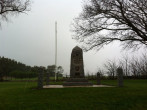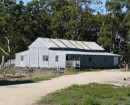AVENUE OF HONOUR
CRESWICK-NEWSTEAD ROAD KINGSTON, HEPBURN SHIRE
-
Add to tour
You must log in to do that.
-
Share
-
Shortlist place
You must log in to do that.
- Download report









Statement of Significance
What is significant?
How is it significant?
Why is it significant?
-
-
AVENUE OF HONOUR - History
HISTORY
CONTEXTUAL HISTORY
Since the early 1900s, commemorative avenues of trees have been planted in Australia and internationally to honour those who have served in wartime. Becoming commonly known as 'avenues of honour', they were first planted in Victoria at Horsham and Apsley to the west of the state in 1902, to commemorate soldiers who fought in the Boer War. During and after World War I, avenues of honour were particularly popular in Victoria with some 218 memorial avenues planted throughout the state. Victoria has the largest number of avenues of honour of any state or territory in Australia.
From the 1850s, there was a civic movement in Australia to create parks, gardens and tree-lined streets in order to beautify and improve the amenity of towns. This was strengthened with the introduction of Arbour Day in Australia in 1889, a day when coordinated tree plantings took place in local communities. These days were very popular in rural communities and local school children were often involved in the plantings. Tree plantings of a commemorative nature also took place in the nineteenth and early twentieth centuries. Trees were often planted in public spaces by both local and visiting dignitaries at official ceremonies to commemorate special occasions such as royal events and the opening of new buildings. From the mid-nineteenth century, royal tours to Australia often included the planting of commemorative trees.
World War I had an immense impact on Australia, more than any other event since British settlement, with over 200,000 Australians killed or injured in just four years. This tragedy pervaded all communities and resulted in commemoration in a number of different ways. This included honour boards, war memorial statues and monuments and the planting of trees to form an avenue of honour, with each tree planted to commemorate a person who served, no matter their rank. Considered a symbol of hope for the future, trees had the additional benefit of beautifying towns and the surrounding countryside, particularly in Australia where the landscape was regarded as being largely undeveloped. The majority of avenues of honour were planted along major roads where they received maximum public exposure and their distinctive form became important aesthetic elements along the main roads of small towns in country Victoria. A range of different tree species were used, more commonly exotic species such as elms, oaks and cypress, and occasionally native species such as eucalypts.
Unlike most types of memorials, the planting of a commemorative avenue of trees enabled entire communities to become involved in commemorating those involved in the war. This was encouraged by an official initiative from the State Recruiting Committee of Victoria, which wrote to all municipalities and shires in 1917 recommending that an assurance should be given to every intending recruit that 'his name will be memorialised in an Avenue of Honour'. As a result Victoria became the heartland of such avenues as they were promoted early and strongly, and a total of some 218 avenues were planted to commemorate World War I in Victoria.
The first avenue of honour identified in Victoria to commemorate World War I was planted at Eurack (VHR H2101) in the Western District of the state in May 1916. This was a single row of twenty Dutch elms with white crosses containing name plaques placed at the foot of each tree. The largest avenue was planted at Ballarat (VHR H2089) from 1917 to 1919. This avenue comprised over 3000 trees of various species which were planted to commemorate the soldiers and some nurses from the district who served their country. This avenue appeared to influence other communities in the surrounding districts to plant similar avenues.
The avenues were symbols of a national cause of commemoration but also allowed individual communities to express their local identity and independence. Together with honour boards, this form of memorial allowed communities to create immediate memorials, and avenues preceded the erection of war-related monuments and statues, often by a significant number of years. A high level of community participation was generally required for both raising funds and planting the trees. Trees were often donated and planted by voluntary labour and as part of a local civic ceremony. The local council and progress association were often the instigators of the projects and many meetings included discussions to determine the location of the avenue, the tree type, the form of tree guard and the provision, type and arrangement of name plaques. Local councils often contributed financially to the avenue and frequently the community was also asked to contribute. Once the location was decided, numerous working bees were held to prepare for the final planting of the trees. The local Red Cross societies were involved in providing refreshments for these occasions.
Commemoration after World War II was more commonly utilitarian, with the building of memorial halls and swimming pools and the planting of gardens in Victoria. Avenues of Honour declined in popularity however some existing avenues were extended after the war and a small number of avenues were planted. The latter included the Calder Woodburn Memorial Avenue (VHR H1975) which was planted along the Goulburn Valley Highway between 1945 and 1949 by Mr J L F Woodburn as a memorial to his son Calder and other local servicemen who did not return from the war. It comprised a total planting of 2,457 Australian native trees. A very small number of commemorative avenues were planted in association with later wars such as the Vietnam War.
In total, over 300 avenues of honour were planted in Victoria to commemorate service personnel in the twentieth century. The majority of these, approximately 218, were planted as World War I memorials between 1917 and 1921. This compares with significantly fewer avenues in other Australian states, with well less than this number planted in the other states combined.
HISTORY OF PLACE
It was noted at a meeting of the Creswick Shire Council in July 1917 that a number of avenues of honour were being planted at different places in Victoria in recognition of the soldiers who had gone to war. It was suggested that an avenue of honour could be planted in the Creswick Shire along the main street at Kingston, the administrative centre of the Shire, to both recognise the contribution being made by local men and to beautify the town. The idea was supported however it was considered too late to plant that year and the planning of the avenue was deferred until the following year.
At a public meeting in April 1918, it was decided that the proposed planting of an avenue of honour should proceed in honour of all the men and women from the shire who had enlisted since the war began. There was considerable discussion as to the most suitable site for the avenue; that selected was described as 'on the main Ballarat-Castlemaine Road', between Kingston and Springmount. It was decided at this meeting that funds would be raised by voluntary contribution and that the avenue would include all those from the shire who enlisted locally and those who enlisted elsewhere. An expert was to be consulted about the species of tree to be planted and a decision was made on the design of the tree guards. A committee for the development of the avenue was formed comprising representatives from each district of the shire.
At a committee meeting on 21 June 1918 it was decided that name plates would be printed in black on a white background with name, rank and battalion shown, and a Maltese cross included for those killed in action. Numerous working bees were held to cart and erect tree guards, dig holes, form drains and place name plates on guards. Various meetings of the branches of the Red Cross Society in the Creswick Shire were held at this time to organise arrangements for catering for working bees and at the planned planting of the avenue in August.
The planting of the trees and the opening ceremony of the Creswick Avenue of Honour was held on Saturday 10 August 1918 with Sir Alexander Peacock, former Premier of Victoria, performing the official duties. It was reported that about 1000 people were in attendance. After an initial estimate of 150 trees, 225 trees were planted at the opening ceremony, and the avenue was described as being about 2 ¼ miles (3.6 km) in length. At this time it was noted that a number of soldiers had not been provided for and that further plantings could occur, and it is recorded that 286 trees were actually planted in total. Trees were planted either side of the road and the selected species was described at the opening as Canadian elm which was considered a suitable species for the location. The trees in the avenue are however predominantly Dutch elms (Ulmus x hollandica). Plaques were attached to tree guards with the name of each soldier or nurse who had served. Seven nurses are represented in the avenue.
Speeches were made at the opening ceremony by the former Premier and a number of local councillors. These included congratulatory remarks and words of encouragement as the war was still being fought at the time. In his speech, Alexander Peacock remarked that:
The boys in France, when they read of the planting of the avenue or receive snapshots, would see that they had not been forgotten. God grant that the avenue of honour would grow and prosper. Their children's children would sit in the shade of the trees and tell of the noble and unselfish sacrifices of the boys of the Creswick Shire. Let them treasure and protect the avenue, and remember those who had done so much for us. [Creswick Advertiser, 13 August 1918, pp2-3]
Nine years later, a Harcourt granite monument, in the form of an obelisk, was unveiled by Brigadier-General H E Elliot on 18 December 1927 to mark the avenue. This is located at the Kingston end of the avenue at the corner of Victoria Road. A stone plaque reads 'Shire of Creswick Avenue of Honour a tribute to the men and women who served in the Great War 1914-1918' and a plaque has been added to commemorate 'The service of our men and women in World War I, World War II, and in the Borneo, Korea and Vietnam campaigns. Only those deserve freedom who are prepared to defend it. Lest we forget.'
In 1999 the Friends of the Avenue, Kingston group was formed and this resulted in repair of the avenue, removal and replacement of damaged plaques, placement of a new memorial plaque and construction of an obelisk listing all names contained in the Avenue of Honour. A Management Strategy Plan for the avenue was developed in 2002.
KEY REFERENCES USED TO PREPARE ASSESSMENT
S Cockerell. 'Summary of the history and state of Australia's Avenues of Honour', unpublished thesis, 2007
J Haddow. 'Avenues of Honour in Victoria', University of Melbourne 1987
J Wadsley Planning and Heritage Consultancy, 'Conservation Management Plan - Ballarat Avenue of Honour and Arch of Victory', prepared for the City of Ballarat, 2014
D Rowe, 'War related heritage in Victoria: a report; Botanic features: Avenues of Honour', Dept Planning and Community Development, Melbourne 2011
Victorian War Heritage Inventory at www.vhd.heritage.vic.gov.au/vhd/veterans
National Trust of Australia (Victoria) Database
S Jeffrey, 'Kingston Avenue of Honour Management Strategy Plan', 2002
Hepburn Shire Council Heritage Citation report for War Memorial, 1990
Ballarat Courier, 6 July 1917, p 5; 17 April 1918, p 6
Creswick Advertiser, 30 April 1918, p 3; 21 June 1918, p 3; 23 July 1918, p 2; 13 August 1918, pp2-3
Personal correspondence with Ms J Baulch, 23 September 2014
AVENUE OF HONOUR - Plaque Citation
This Avenue of Honour was planted in 1918 by the local community for the Creswick Shire with each tree, predominantly Dutch elm, representing a local enlisted serviceman or woman. It is one of more than 200 World War I avenues planted in Victoria.
AVENUE OF HONOUR - Assessment Against Criteria
Criterion
The Avenue of Honour, Kingston is significant at the State level for the following reasons:
The Avenue of Honour, Kingston is historically significant for exemplifying rural Victoria's reaction to World War I. It is significant as a fine example of this important form of memorial planting in Victoria which commemorated individual sacrifice during World War I. It is representative of many plantings that appeared in Victoria, particularly during World War I, commemorating all those who enlisted for service in an egalitarian form where each individual, regardless of rank, was equally recognised for their service. The 1927 war memorial which marks the avenue, later memorials and name plaques, and any earlier name plaques retained in storage, are important for their associations with the Avenue of Honour. [
Criterion A]
The Avenue of Honour, Kingston is aesthetically significant as an outstanding planting of predominantly Dutch elm (Ulmus x hollandica) which is an extensive, largely intact and highly distinctive commemorative planting. The planting of 285 trees (originally 286 trees) on both sides of the road produces a dramatic and continuous avenue, which contrasts markedly with the pastoral surroundings. The avenue is an impressive and imposing visual and cultural landmark and a key landscape feature of the district. [
Criterion E]
The Avenue of Honour, Kingston is also significant for the following reasons, but not at the State level:
The Avenue of Honour, Kingston is socially significant at a local level for its relationship with the community as a memorial to those who served in World War I and for its continuing commemorative importance. It remains as an indication of the involvement of Victoria's small communities in commemorating the sacrifices of their volunteers, along with the loss and sorrow experienced in small rural areas such as the Shire of Creswick.
The Avenue of Honour, Kingston is of local significance for its relationship with the local street planting of elms along the main street of Kingston and with the Shire Hall building. This council planting, which appears to predate the Avenue of Honour, extends to the north from Victoria Road and provides a visual continuation of the memorial planting. The small town of Kingston was the administrative centre of the Shire in 1918 when the Shire of Creswick established a committee to provide an avenue of honour to district servicemen. This resulted in the location of the Avenue of Honour at Kingston rather than in the larger town of Creswick.AVENUE OF HONOUR - Permit Exemptions
General Exemptions:General exemptions apply to all places and objects included in the Victorian Heritage Register (VHR). General exemptions have been designed to allow everyday activities, maintenance and changes to your property, which don’t harm its cultural heritage significance, to proceed without the need to obtain approvals under the Heritage Act 2017.Places of worship: In some circumstances, you can alter a place of worship to accommodate religious practices without a permit, but you must notify the Executive Director of Heritage Victoria before you start the works or activities at least 20 business days before the works or activities are to commence.Subdivision/consolidation: Permit exemptions exist for some subdivisions and consolidations. If the subdivision or consolidation is in accordance with a planning permit granted under Part 4 of the Planning and Environment Act 1987 and the application for the planning permit was referred to the Executive Director of Heritage Victoria as a determining referral authority, a permit is not required.Specific exemptions may also apply to your registered place or object. If applicable, these are listed below. Specific exemptions are tailored to the conservation and management needs of an individual registered place or object and set out works and activities that are exempt from the requirements of a permit. Specific exemptions prevail if they conflict with general exemptions. Find out more about heritage permit exemptions here.Specific Exemptions:PERMIT EXEMPTIONS
It should be noted that Permit Exemptions can be granted at the time of registration (under s.42(4) of the Heritage Act). Permit Exemptions can also be applied for and granted after registration (under s.66 of the Heritage Act)
General Condition: 1.
All exempted alterations are to be planned and carried out in a manner which prevents damage to the fabric of the registered place or object.General Condition: 2.
Should it become apparent during further inspection or the carrying out of works that original or previously hidden or inaccessible details of the place or object are revealed which relate to the significance of the place or object, then the exemption covering such works shall cease and Heritage Victoria shall be notified as soon as possible.General Condition: 3.
All works should be informed by Conservation Management Plans prepared for the place.General Conditions: 4.
Nothing in this determination prevents the Executive Director from amending or rescinding all or any of the permit exemptions.General Condition: 5.
Nothing in this determination exempts owners or their agents from the responsibility to seek relevant planning or building permits from the relevant responsible authority, where applicable.Vegetation Exemptions:
. Removal of dead or dangerous trees and emergency tree works to maintain public safety and to protect buildings and structures providing the Executive Director is notified within 21 days of the removal or works occurring.
. Management and maintenance of trees, including formative and remedial pruning, removal of deadwood, pest and disease control, cabling, mowing, weed control and mulching.
. In the event of loss or removal of trees, replanting with the same species that has been removed.
. Removal of tree seedlings and suckers but excluding herbicide use.
. Management of trees in accordance with Australian Standard; Pruning of amenity trees AS 4373.
. Management of trees in accordance with Australian Standard; Protection of trees on development sites AS 4970.
. Removal of plants listed as prohibited and controlled weeds in the Catchment and Land Protection Act 1994.
Hard Element Exemptions:
. Repair, maintenance, replacement and removal of existing structures and hard landscape elements such as driveways and crossovers, stone and concrete edging, fences and gates.
. All road and pavement works to the Creswick-Newstead Road (Kingston Road) and any intersecting road within the extent of registration from shoulder to shoulder.
. Traffic management and safety works including removal and installation of traffic and directional signs, reflector posts, and line marking.
. Minor repair, maintenance and conservation by a qualified conservator to memorial monuments and name plaques in a manner which preserves the cultural heritage significance of the place.
AVENUE OF HONOUR - Permit Exemption Policy
Preamble
The purpose of the Permit Policy is to assist when considering or making decisions regarding works to a registered place. It is recommended that any proposed works be discussed with an officer of Heritage Victoria prior to making a permit application. Discussing proposed works will assist in answering questions the owner may have and aid any decisions regarding works to the place.
The extent of registration of the Avenue of Honour, Kingston on the Victorian Heritage Register affects the whole place shown on Diagram 2343 including the land, road, trees, memorials and plaques. Under the Heritage Act 1995 a person must not remove or demolish, damage or despoil, develop or alter or excavate, relocate or disturb the position of any part of a registered place or object without approval. It is acknowledged, however, that alterations and other works may be required to keep places and objects in good repair and adapt them for use into the future.
If a person wishes to undertake works or activities in relation to a registered place or registered object, they must apply to the Executive Director, Heritage Victoria for a permit. The purpose of a permit is to enable appropriate change to a place and to effectively manage adverse impacts on the cultural heritage significance of a place as a consequence of change. If an owner is uncertain whether a heritage permit is required, it is recommended that Heritage Victoria be contacted.
Permits are required for anything which alters the place or object, unless a permit exemption is granted. Permit exemptions usually cover routine maintenance and upkeep issues faced by owners as well as minor works. They may include appropriate works that are specified in a conservation management plan. Permit exemptions can be granted at the time of registration (under s.42 of the Heritage Act) or after registration (under s.66 of the Heritage Act).
Conservation management plans
A Kingston Avenue of Honour Management Strategy Plan was prepared by arborist Shane Jeffrey in 2002 and presented to the Hepburn Shire Council, although not formally adopted. The Hepburn Shire Council is encouraged to review this plan in order to guide the future management of the avenue.
Cultural heritage significance
Overview of significance
The cultural heritage significance of the Avenue of Honour, Kingston is as an intact and fine commemorative planting that symbolises the response of a rural community to World War I. Each tree is dedicated to an individual soldier and contributes to the significance of the Avenue of Honour as a whole. It is significant as an extensive and uniform avenue of Dutch elm (Ulmus x hollandica) and as an impressive landscape feature.
a) All of the features listed here are of primary cultural heritage significance in the context of the place. A permit is required for most works or alterations. See Permit Exemptions section for specific permit exempt activities:
. All the trees that are contained within the land identified in Diagram 2343
. All memorial monuments and associated plaques
. All individual name plaques.
b) The following features are of no cultural heritage significance. See Permit Exemptions section for specific permit exempt activities:
. property fences
. road signs
. road safety posts.
Protection of trees and memorial area
All works should ensure the protection of the trees and the aesthetic value of the avenue street plantings. The following works and activities within the road reserve will require the approval of the Executive Director, Heritage Victoria. An arborist's report is likely to be required to determine the impact of the works on the trees.
. Excavation works
. Drainage works
. New driveways, culverts and crossovers
. Works associated with water, gas, power, sewer or similar services.
Any changes to the war memorials and name plaques, other than minor repairs, maintenance and conservation by a qualified conservator, will require the approval of the Executive Director of Heritage Victoria. The retention of damaged name plaques, held in storage in Kingston, is encouraged.
Parking within the root zone of the trees should be discouraged.
-
-
-
-
-
KINGSTON GRANDSTAND
 Victorian Heritage Register H1300
Victorian Heritage Register H1300 -
Former Holy Trinity Church of England
 National Trust H0959
National Trust H0959 -
Foirmer Holy Trinity Church of England
 National Trust
National Trust
-
1 Brockenshire Street
 Yarra City
Yarra City -
1 Bundara Street
 Yarra City
Yarra City -
1 Forster Street
 Hobsons Bay City
Hobsons Bay City
-
-
Images See all images













